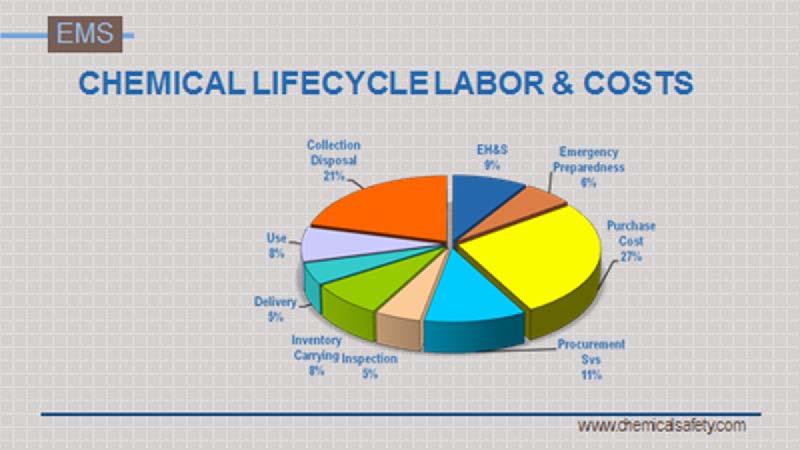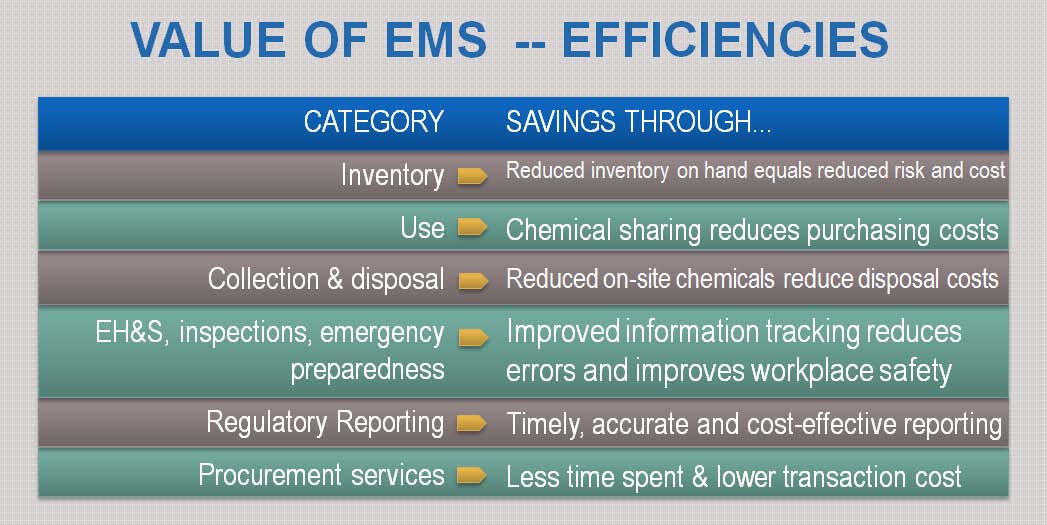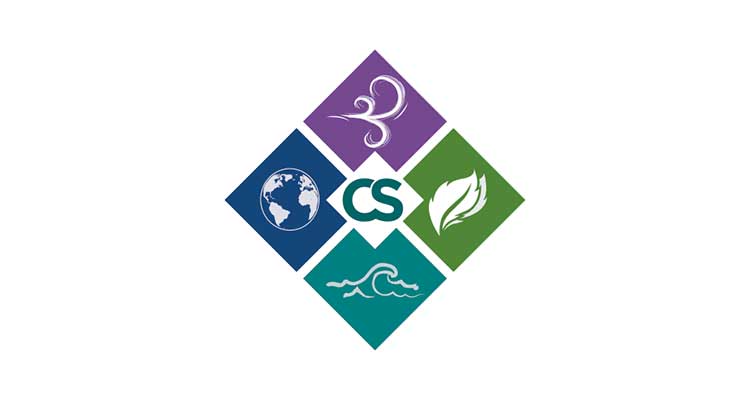For cost savings, regulatory compliance and environmental responsibility
If you ask industrial and laboratory operations managers about their biggest challenges, the answers you’ll hear most often relate to environmental regulations and the management of chemicals. And the concern permeates the whole organization as well — according to Accenture and the Conference Board, over one third of 500 top US CEOs named chemical-related Environmental Health and Safety issues among the biggest concerns in their businesses and industries, placing it in the top five on the list of responses. Cost, process, regulatory and safety issues converge around chemical management, making it a critical, complex and cumbersome activity.
The true cost of a chemical as it completes its lifecycle is much more than the purchase price alone. Additional costs include compliance, inventory management, safety, facilities, and disposal. Management costs can range from $1.00 to $10.00 for every dollar of chemicals purchased. Best practices that address the various aspects of chemical management can significantly reduce the extra costs in a chemical’s lifecycle.
The chart below represents an average Chemical Lifecycle cost for corporate and industrial operations.

Environmental Health and Safety is sometimes viewed as ‘outside’ the business process, and given less attention than other practices. For example, companies often treat procurement of chemicals or hazardous materials the same as they handle any other purchases, without planning for the unique storage, reporting, and eventual disposal requirements. Although financial data is specifically and meticulously analyzed, the impact of chemical management choices is often neglected. These choices have far reaching effects and can sometimes be catastrophic for an organization. Viewing EH&S as a critical part of the business process and integrating it with other activities can raise efficiency of chemical management and provide a significant advantage in terms of cost savings, safety, risk management and competition.
Implementing Best Practices helps this integration of EH&S with the organization’s processes, and supports the strategic or business goals of saving money and growing the business. On the day-to-day level, these operations affect the tactical or management goals of increased safety and decreased legal and regulatory risk. Reviewing the impact, cost savings and benefits become clear.
Best Practices for Chemical Management
- Purchase only the chemicals and amounts required
- Reduce inventories and store only what is almost immediately needed
- Improve inter-facility and intra-facility delivery of chemicals
- Reduce infrastructure costs
- Increase environmental regulatory compliance and decrease legal liability
- Facilitate data interchange to and from EHS systems and ERP/MRP systems
- Increase operational safety for workers and the community
- Streamline environmental compliance and reporting
- Enhance a corporate image of responsibility and safety
- Minimize hazardous waste disposal
- Automate repetitive and low-value tasks
- Conserve human resources for more value-added tasks
More Best Practices…
Capture data available at critical junctures of the supply chain. Companies must integrate Environmental Health and Safety into their process. Data is collected, generated, and modified in purchasing/ERP systems or vendor systems. This data can and should be automatically captured and transferred to an EMIS (Environmental Management Information System). There may be some effort needed to collect and manage the appropriate data, but the payoff by far outweighs this effort.
When EH&S information is managed by integrated systems, underlying other departments’ data and programs, it supports best practices in other processes – purchasing, delivery, receipt, inventory management. Improved data will increase compliance efficiency for audits, inspections, permits and reporting.
Having data readily available makes inspections and audits less intrusive, less threatening and less likely to result in a negative outcome. Using an EMIS to manage critical chemical information and Right-to-Know data ensures that information is available and accurate, and it complies with OSHA and ISO 14000 mandates.
With improved computer technology, data transfer and compatibility between systems is readily available. Chemical managers can select from a full range of user interfaces, from a simple web browser on the production floor, to sophisticated inter-system reporting tools, all accessing the same data. Although organizational needs vary, with some research and analysis, chemical managers can now find viable solutions within their budget to meet EH&S information management needs.
Beware, however: ERP/MRP systems such as those offered by SAP, Oracle, J.D. Edwards and Baan, among others, remain deficient in their environmental management offerings. This is primarily due to the complex, diverse and evolving nature of environmental regulations and the reporting requirements of local, state, federal and international jurisdictions. Organizations that have opted for environmental solutions that have been rolled into ERP/MRP implementations have regularly reported disappointing results. Dedicated environmental management information systems should be used in conjunction with ERP systems. Further, be sure to carefully evaluate the buy-vs-build question. A comprehensive system is complex to develop and difficult to maintain. Studies have shown that a company will break even within one year when using an off-the-shelf, automated solution versus a manual homegrown system.
Develop preferred vendor relationships. This is the surest way to standardize product, ensure delivery and negotiate best prices. Vendors will ensure product flow and preferred price in exchange for the increased efficiency of a “committed” business relationship. Advantages of preferred vendor relationships reach beyond cost savings, as finding and evaluating materials is simplified, electronic payments decrease administrative overhead and vendors become better resources for information. Significantly to chemical management, preferred vendors are often more willing accommodate information exchange in each direction in order to maintain good relationships with dedicated customers. Organizations that have created exclusive or preferred vendor relationships have often negotiated very favorable agreements with chemical suppliers.
Use online purchasing systems, exchanges, or vendor sites. On-line procurement decreases the time and cost of purchasing paperwork. On-line purchasing and management allows approval and monitoring of purchases by line managers, and provides purchasing guideline compliance and information interchange. More steps of the purchasing process can be automated, significantly reducing effort. A fortuitous by-product of automated purchasing is the availability of data. All on-line purchasing systems produce data that, sometimes with considerable effort can be downloaded, transferred, and used by a chemical inventory system or EMIS.
Track chemicals efficiently. Many plants find that using a supply chain management system to closely track incoming material shipments allows them to time and plan delivery more accurately, reducing inventory levels, ensuring smooth operations and supporting environmental compliance goals. Supply chain management can also help optimize shipment methods, routes and vendors for overall cost and time efficiencies. Centralized receiving supports tracking and management of chemicals within the facility, keeping information on inventory levels accurate and up to date. It also simplifies the use of inhouse barcoding of materials for tracking within the facility. Barcode labels are one of the best support tools for inventory control, waste minimization and environmental compliance and reporting. This data shared by an EMIS creates a powerful and efficient tool for EH&S operations.
Manage inventory well. The best way to accurately and efficiently maintain chemical inventory information is to use focused inventory management software or an online application. The best of these systems will interface with purchasing systems, vendors or online suppliers to maintain dynamic inventory data. Because chemical inventories have special requirements for information and availability, it is best to gather this information electronically from the originating source as often as possible. This requires the cooperation of several distinct groups: the vendor, the purchasing department, the IT system provider, the IT department and the EH&S department.
Good inventory management lowers inventory, which requires less space for storage, lower carrying costs and less capital tied up in stored materials. Understanding when, where and how materials are used gives an organization the tools to determine where in the process usage can be reduced, when alternative materials can be introduced and/or which processes/units are good candidates for sharing chemicals. An effective inventory management system can improve the sharing or redistribution of chemicals. Often, line managers purchase a chemical because they simply had no way of knowing someone else in the facility had excess product available. This decreases inventory, storage, and potential for waste disposal because of “expired shelf life”.
Manage and reduce hazardous waste. The obvious first step to cost-savings in waste disposal is to minimize the waste. Chemical waste disposal is the most expensive cost associated with a chemical, and sometimes it is greater than the cost to purchase that chemical! Process evaluation with an understanding of the costs associated with disposal of hazardous waste or regulated materials will uncover savings opportunities in this area. Efficient inventory of hazardous materials necessarily decreases the amount of waste disposed. When hazardous waste must be disposed, there are still ways to save money. Electronic transfer of data and documents streamlines the process and supports the verification process, ensuring all aspects of generating, storing, shipping and destroying hazardous waste receive proper attention and the company’s responsibilities are covered in the event of inspection, audit or emergency.
A good relationship with a TSDF or waste disposal company can improve operations as well. Many waste disposal companies now offer online approval of waste streams, automated scheduling for pick-up, and regulatory data transfer. There are not many players in this industry, and some are much better at this than others, so careful selection of a vendor is very important. Recycling, whenever possible, is another great way of saving money, limiting waste and contributing in a positive way to the environment and the community.
Calculate and re-engineer operations. Process engineering supported by ongoing information streams can further enhance efficiency of chemical use. Calculating the total costs associated with chemical management and evaluating the products themselves in lean-engineering or waste-minimization terms may suggest better processes or less hazardous substitutes. This can affect the efficiency of many areas of chemical management and environmental compliance by dealing with associated costs and issues before they arise.
An evolving market in chemical management is the outsourcing of this operation to Chemical Management Services’ (CMS’s). Chemical suppliers’ roles expand from simple sale and delivery of chemicals to full evaluation and management of their customers’ on-site products. Chemicals are stored in quantity at the vendor until the customer needs a chemical for a specific task. CMS’s completely take over responsibility for their clients’ chemical inventories, MSDS’s, safety, and hazardous waste, and generate required regulatory and management reports. These providers recognize the absolute necessity of a comprehensive information infrastructure supporting their materials management operations.
Invest in information management systems. Companies’ chemical managers and the EH&S community recognize that the most important investment in the next decade will be technology for information management. The good news for chemical managers is that technology innovation is offering data interfaces and reporting capabilities previously impossible. It has never been easier or efficient to exchange data with external sources such as vendors or with internal sources, such as ERP/MRP or purchasing systems. User-friendly reporting tools can access data from a number of sources and fulfill regulatory reporting and support business analysis. Web interfaces for line personnel offer easy access to critical real-time and accurate information.
One important consideration as you embark, or re-embark into information management solutions is determining who will be responsible for the integration and support of the information that needs to be managed. In-house IT departments traditionally frowned upon outside vendors taking away responsibility from them; with the opportunities and pressures of new technologies, however, and especially with the emergence of the web, outsourcing EH&S implementation projects has become a preferred option. Select an EH&S vendor who has “domain experience”, or, in simpler terms, a clear understanding of the environmental needs and benefits that organizations have and who will be willing to partner with you as your requirements and expectations change.
The Bottom Line
The costs of managing chemicals are far more than just the product price, but the life-cycle management of chemicals can be optimized to cut these peripheral costs. By adopting best practices, the chemical management process is more integrated into the business process, becoming a strategic advantage to the organization, raising efficiency on a number of fronts, decreasing legal liability and risk and improving plant/laboratory safety, as well as offering bottom line cost savings. Improved information management systems are becoming more functional and less costly, making these process improvements possible. Such systems are still an investment, and costs of re-engineering operations and changing current processes must be considered, but the savings of a concerted, focused effort to improve chemical management are significant, and the ROI quickly justifies the costs.
The chart below offers a snapshot of efficiencies and cost-benefits that can be achieved through the implementation of an integrated, fully-functional Environmental Management System.

For more information and an evaluation of your organization’s operational needs and requirements, please contact Tony Diamantidis, Executive Vice-President, SFS Chemical Safety, Inc.
Email: tonyd@chemicalsafety.com
Tel: (510) 594-2020
LinkedIn: www.linkedin.com/in/tonydiamantidis

